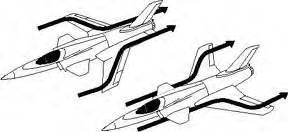It looks like you're using an Ad Blocker.
Please white-list or disable AboveTopSecret.com in your ad-blocking tool.
Thank you.
Some features of ATS will be disabled while you continue to use an ad-blocker.
0
share:
Delta Wing:
Advantages of the delta wing are simplicity of manufacture, strength, and substantial interior volume for fuel or other equipment. Because the delta wing is simple, it can be made very robust (even if it is quite thin), and it is easy and relatively inexpensive to build - a substantial factor in the success of the MiG-21 and Mirage aircraft.
More recently, with the advent of aircraft with relaxed or no natural stability, and the therefore necessary computer controlled/assisted control systems (fly-by-wire or FBW), the horizontal control surfaces are often moved forward to become a canard in front of the wing to control the aeroplane as the normal elevator does. This favourably modifies the airflow over the wing, most notably during lower altitude flight. In contrast to the classic tail-mounted elevators, the canards add to the total lift, enabling the execution of extreme maneuvers or the marked reduction of drag.
Forward-Swept Wing
The forward-swept wing is a high-performance aircraft configuration, first proposed in 1936 by a German aircraft designer.[1] Perceived benefits of a forward-swept wing design include
mounting the wings further back on the fuselage, allowing for an unobstructed cabin or bomb bay, and
increased maneuverability at transonic speeds, due to airflow from wing tip to wing root preventing a stall of the wing tips and ailerons at high angle of attack.

[edit on 25/11/2006 by ShadowOrphan]
[edit on 25/11/2006 by ShadowOrphan]
Advantages of the delta wing are simplicity of manufacture, strength, and substantial interior volume for fuel or other equipment. Because the delta wing is simple, it can be made very robust (even if it is quite thin), and it is easy and relatively inexpensive to build - a substantial factor in the success of the MiG-21 and Mirage aircraft.
More recently, with the advent of aircraft with relaxed or no natural stability, and the therefore necessary computer controlled/assisted control systems (fly-by-wire or FBW), the horizontal control surfaces are often moved forward to become a canard in front of the wing to control the aeroplane as the normal elevator does. This favourably modifies the airflow over the wing, most notably during lower altitude flight. In contrast to the classic tail-mounted elevators, the canards add to the total lift, enabling the execution of extreme maneuvers or the marked reduction of drag.
Forward-Swept Wing
The forward-swept wing is a high-performance aircraft configuration, first proposed in 1936 by a German aircraft designer.[1] Perceived benefits of a forward-swept wing design include
mounting the wings further back on the fuselage, allowing for an unobstructed cabin or bomb bay, and
increased maneuverability at transonic speeds, due to airflow from wing tip to wing root preventing a stall of the wing tips and ailerons at high angle of attack.

[edit on 25/11/2006 by ShadowOrphan]
[edit on 25/11/2006 by ShadowOrphan]
I starteda thread a long time ago about FSW planes. It might be of some interest to you.
www.abovetopsecret.com...
www.abovetopsecret.com...
new topics
-
Con Man Don
Jokes, Puns, & Pranks: 1 minutes ago -
How can you defend yourself when the police will not tell you what you did?
Posse Comitatus: 3 hours ago
0
